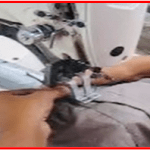Workstation Layout Optimization
Arrange tools, machines, and materials ergonomically to minimize operator movements.
Introduce a one-piece flow layout instead of a batch system for smoother operations.
Use of Work Aids and Attachments
Implement automated or semi-automated devices like folder attachments, guides, or clamps.
Examples:
Hemming folder for consistent and faster hems.




Box all-around measurement is 100% equal for all the garments and SMV Save 0.50 to 0.60
Belt loops in one shot fold and bartack without tack loop into the waist band using a Bartack machine.
SMV Save 0.35 to 0.40
Half-rib and half-self-fabric waistband using a double needle lockstitch machine with a folder. SMV Save 5.63 to 6 minutes
Waist Band attach by folder with mouth close SMV Save 1.15 to 1.25 minutes
Method Improvement
Perform time and motion studies to identify unnecessary movements and streamline tasks.
Simplify operations such as bundling, thread cutting, or fabric alignment.
Train workers to use the most efficient sewing techniques.
Line Balancing
Balance the workload between operators to ensure no bottlenecks or idle times.
Use takt time calculations to adjust processes for uniform production flow.
Skill Development
Conduct training for workers to master operations that require high skill levels.
Crosstrain operators for better flexibility in handling multiple tasks.
Quality at the Source
Reduce rework by implementing in-line quality checkpoints.
Ensure operators follow standard operating procedures to maintain the garment’s look.
Standardized Work Instructions
Create clear visual work instructions to ensure consistent quality.
Define step-by-step processes to reduce variation between operators.
Incorporate machines like computerized sewing machines for critical processes (Robot Arm Loding pocket setter and Small Parts overlock, Collar band attach, Auto Jig, Automatic Feeding Horn and Shank feeder, Profile machine, use fabric cutters or CAD systems for accurate cutting etc. reducing manual labor.
Reduce Idle Time
Introduce small buffers of materials to prevent downtime due to waiting.
Use an automated conveyor system to transport garments between processes.
Continuous Improvement (Kaizen)
Set up a team to consistently evaluate processes and identify inefficiencies.
Involve operators in brainstorming sessions for process improvements.
Metrics to Monitor:
SMV reduction percentage.
Daily production units compared to the target.
Defect rates to ensure garment aesthetics remain unaffected.
By combining these strategies, you can effectively lower SMV, boost productivity, and ensure the garment’s design and aesthetic integrity remain unchanged. Would you like help tailoring a specific implementation plan or conducting a process simulation.
#groyyo #groyyoconsulting #kaizen #optimization #automation #efficiency #quality #technology


Leave a Comment